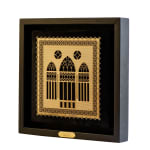Jihan C
Elie Saab Triple Arch Wall Display Box Set
24k gold plated metal facade on black velvet base with wooden black frame
30 x 30 x 6 cm
Copyright The Artist
AED 2,161.90
Further images
In Lebanon, the house with triple arches appeared in the second half of the 19th century. The house soon became a favorite of the bourgeois class, and represented a new...
In Lebanon, the house with triple arches appeared in the second half of the 19th century. The house soon became a favorite of the bourgeois class, and represented a new form of urban architecture inspired by elements of Ottoman modernity.
The house was centered on a large central hall or room. It featured a triple arched window, a central element of its design, which opened onto a narrow balcony and a garden, or a street, or landscape.
The Lebanese "Gothic" triple arched window represented here comes from the home of world-renowned fashion designer Elie Saab in Beirut's Gemayzeh district. With a deep appreciation of the traditional style, the designer undertook an extensive yet delicate restoration of the 20th century mansion and preserved its unique features for generations to come.
The colorful geometric patterned tiles used in residential buildings of the 1920s and 1930s, locally known as "Cemento", were produced in local tile factories, by skilled workers, using cast iron molds and a water press. The "Cemento" tiles in Elie Saab's residence are represented here as the peripheral framing of the artwork.
The house was centered on a large central hall or room. It featured a triple arched window, a central element of its design, which opened onto a narrow balcony and a garden, or a street, or landscape.
The Lebanese "Gothic" triple arched window represented here comes from the home of world-renowned fashion designer Elie Saab in Beirut's Gemayzeh district. With a deep appreciation of the traditional style, the designer undertook an extensive yet delicate restoration of the 20th century mansion and preserved its unique features for generations to come.
The colorful geometric patterned tiles used in residential buildings of the 1920s and 1930s, locally known as "Cemento", were produced in local tile factories, by skilled workers, using cast iron molds and a water press. The "Cemento" tiles in Elie Saab's residence are represented here as the peripheral framing of the artwork.






